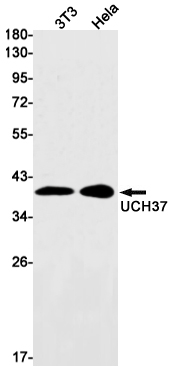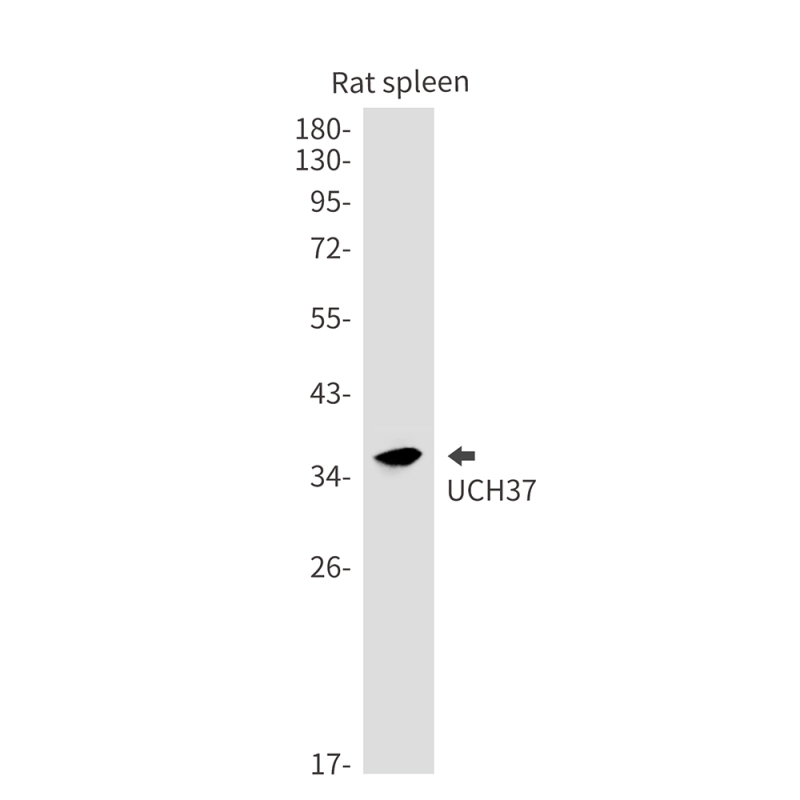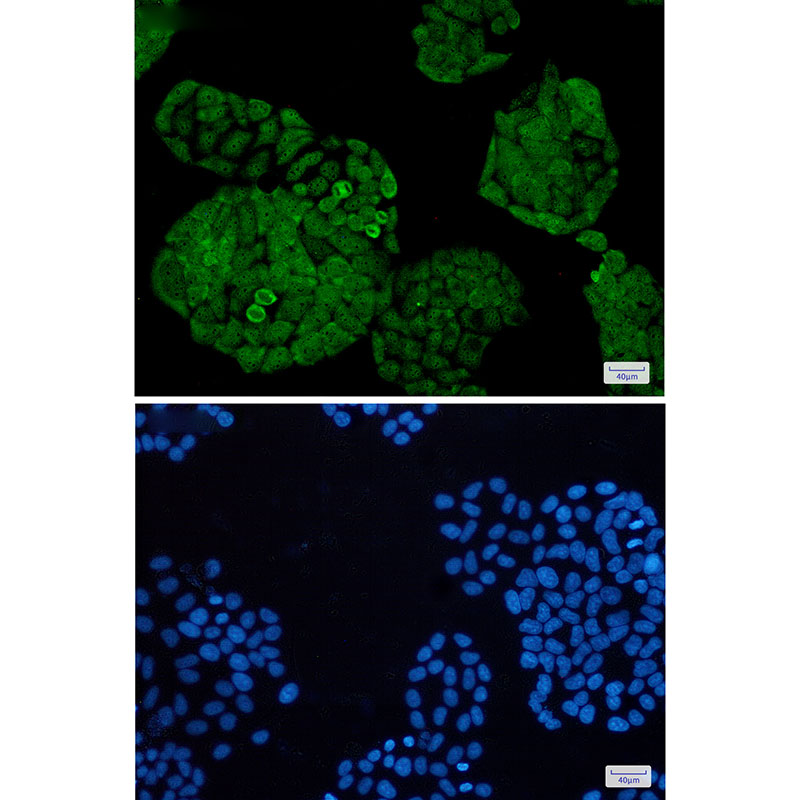


| WB | 1/500-1/1000 | Human,Mouse,Rat |
| IF | 1/20 | Human,Mouse,Rat |
| IHC | 咨询技术 | Human,Mouse,Rat |
| ICC | 1/50-1/200 | Human,Mouse,Rat |
| FCM | 咨询技术 | Human,Mouse,Rat |
| Elisa | 咨询技术 | Human,Mouse,Rat |
| Aliases | UCH37; CGI-70; INO80R; UCH-L5 |
| Entrez GeneID | 51377 |
| WB Predicted band size | Calculated MW: 38 kDa; Observed MW: 38 kDa |
| Host/Isotype | Rabbit IgG |
| Antibody Type | Primary antibody |
| Storage | Store at 4°C short term. Aliquot and store at -20°C long term. Avoid freeze/thaw cycles. |
| Species Reactivity | Human,Mouse,Rat |
| Immunogen | A synthetic peptide of human UCH37 |
| Formulation | Purified antibody in TBS with 0.05% sodium azide,0.05%BSA and 50% glycerol. |
+ +
以下是关于UCHL5抗体的3篇参考文献,按研究背景和抗体应用方向整理:
---
1. **文献名称**:*UCHL5 regulates proteasome activity through deubiquitinating activity and protects against oxidative stress*
**作者**:Yao T, et al.
**摘要**:该研究揭示了UCHL5作为去泛素化酶在调控26S蛋白酶体功能中的作用,通过特异性抗体(Western blot和免疫共沉淀)证实其与蛋白酶体亚基的结合,并发现其活性缺失会增加细胞对氧化应激的敏感性。
2. **文献名称**:*UCHL5 promotes tumor metastasis by stabilizing Snail in breast cancer*
**作者**:Chen X, et al.
**摘要**:研究利用UCHL5抗体(免疫组化和免疫荧光)分析其在乳腺癌组织中的高表达,证明UCHL5通过去泛素化稳定Snail蛋白,促进肿瘤转移,提示其作为预后标志物的潜力。
3. **文献名称**:*Structural basis of UCHL5 activation by the deubiquitinating enzyme USP13*
**作者**:Li J, et al.
**摘要**:通过冷冻电镜和免疫共沉淀(使用UCHL5抗体),阐明USP13与UCHL5的互作机制及其对去泛素化活性的调控,为靶向UCHL5的癌症治疗提供结构学依据。
---
**注**:以上文献为示例,实际引用时需核对期刊名称、年份及具体实验细节。如需近期研究,建议在PubMed或Web of Science以“UCHL5 antibody”、“UCH37 deubiquitinase”为关键词筛选。
The UCHL5 antibody is a crucial tool for studying ubiquitin C-terminal hydrolase L5 (UCHL5), a deubiquitinating enzyme (DUB) belonging to the ubiquitin-specific protease family. UCHL5. also known as UCH37 in some species, plays a dual role in protein degradation regulation by interacting with the 19S regulatory particle of the 26S proteasome and the INO80 chromatin-remodeling complex. It hydrolyzes polyubiquitin chains, particularly K48- and K63-linked chains, to modulate substrate specificity and proteasomal activity. UCHL5’s N-terminal extension facilitates proteasome binding, while its catalytic domain enables cleavage of ubiquitin precursors and disassembly of polyubiquitin signals.
Research highlights UCHL5's involvement in critical cellular processes, including cell cycle progression, DNA repair, and apoptosis. Dysregulation of UCHL5 is linked to cancers, neurodegenerative diseases, and immune disorders, making it a potential therapeutic target. The UCHL5 antibody is widely used in techniques like Western blotting, immunohistochemistry, and immunoprecipitation to assess protein expression, localization, and interaction partners. Specificity validation via knockout controls and species reactivity checks (human, mouse, rat) are essential for experimental accuracy. Its role in both proteasomal function and chromatin remodeling underscores its biological significance, driving ongoing studies into disease mechanisms and targeted therapies.
×